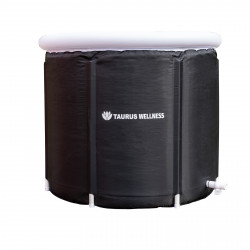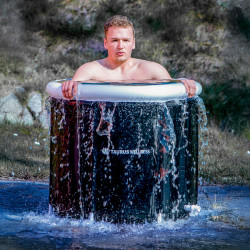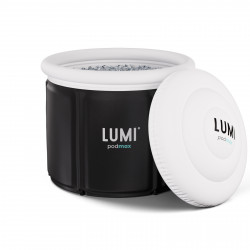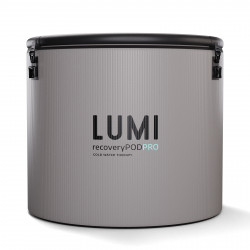Filter
Ice Baths
Embark on a refreshing journey with ice baths, exploring the invigorating effects and innovative solutions for your recovery. Discover the transformative power of cold therapy to energize and renew your well-being
Uncover the scientifically proven benefits, explore cutting-edge ice bath solutions, and elevate your recovery experience.
-
BEFORE £59.99TODAY £53.994 interest-free payments of £13.50
-
RRP £145.00 -38%NOW £89.004 interest-free payments of £22.25
-
RRP £349.00 -5%NOW £329.004 interest-free payments of £82.25
Thinking About Getting an Ice Bath? Start Here
There’s something about sitting in a tub of freezing cold water that sparks curiosity. It sounds a bit mad at first, but once you’ve tried it, you start to see why so many swear by it. Some do it for recovery, others for the headspace. For many, it’s become a solid part of daily life.
This guide covers what ice baths actually are, what they do, and how they compare to other cold therapy options. We’ll go over the benefits, the kit, the setup, and everything else worth knowing before you take the plunge.
This guide covers what ice baths actually are, what they do, and how they compare to other cold therapy options. We’ll go over the benefits, the kit, the setup, and everything else worth knowing before you take the plunge.
What Are Ice Baths?

An ice bath is exactly what it sounds like – sitting in a tub of cold water, usually chilled to somewhere between 4°C and 10°C. Sometimes there’s actual ice involved, sometimes it’s just cold water, but the goal is the same: cooling the body down quickly for physical and mental benefits.
The idea isn’t new. Cold water therapy has been around for centuries and shows up in all sorts of traditions. These days, ice baths have found their way into gyms, homes, gardens and patios. Some people use them after training, others do it as part of their daily routine.
Unlike a quick cold shower, ice baths involve full-body immersion (or at least up to the chest) and tend to last a few minutes at a time. The cold hits fast, and that’s kind of the point – it wakes the system up, gets the blood moving and kicks off a bunch of responses in the body that people say help with everything from mood to muscle recovery.
The idea isn’t new. Cold water therapy has been around for centuries and shows up in all sorts of traditions. These days, ice baths have found their way into gyms, homes, gardens and patios. Some people use them after training, others do it as part of their daily routine.
Unlike a quick cold shower, ice baths involve full-body immersion (or at least up to the chest) and tend to last a few minutes at a time. The cold hits fast, and that’s kind of the point – it wakes the system up, gets the blood moving and kicks off a bunch of responses in the body that people say help with everything from mood to muscle recovery.
Different Ways to Try Cold Therapy
Cold therapy comes in a few different forms. Ice baths are one way to do it, but they’re not the only option. Here’s how they compare to other common methods:
Cold showers: Probably the easiest place to start. You turn the tap cold and step in. The water usually isn’t as cold as an ice bath and you’re not fully immersed, but it still gives you a hit of cold exposure. Some use it as a daily habit or to ease into more intense methods.
Ice baths: This is where things get a bit more serious. You’re fully or mostly submerged in cold water, usually between 4°C and 10°C. The cold hits quickly and stays consistent. It’s more intense than a shower, but the effects on recovery, focus and mood tend to be stronger too.
Open water swimming: Think lakes, rivers or the sea. The temperature depends on the weather and location, but it can get colder than most home setups in winter. It's often less controlled and comes with extra considerations like currents, safety and swimming ability, but it’s also part of what people enjoy about it.
Cryotherapy: This is done in a chamber that blasts the body with extremely cold air, usually below -100°C. You’re in for a short burst, typically a couple of minutes. It doesn’t involve water at all. Some prefer it because it’s quick and dry, though it usually involves going to a clinic or paying for specialist equipment.
Cold showers: Probably the easiest place to start. You turn the tap cold and step in. The water usually isn’t as cold as an ice bath and you’re not fully immersed, but it still gives you a hit of cold exposure. Some use it as a daily habit or to ease into more intense methods.
Ice baths: This is where things get a bit more serious. You’re fully or mostly submerged in cold water, usually between 4°C and 10°C. The cold hits quickly and stays consistent. It’s more intense than a shower, but the effects on recovery, focus and mood tend to be stronger too.
Open water swimming: Think lakes, rivers or the sea. The temperature depends on the weather and location, but it can get colder than most home setups in winter. It's often less controlled and comes with extra considerations like currents, safety and swimming ability, but it’s also part of what people enjoy about it.
Cryotherapy: This is done in a chamber that blasts the body with extremely cold air, usually below -100°C. You’re in for a short burst, typically a couple of minutes. It doesn’t involve water at all. Some prefer it because it’s quick and dry, though it usually involves going to a clinic or paying for specialist equipment.
What Happens to Your Body in an Ice Bath
When you step into cold water, your body responds immediately. Blood vessels near the surface tighten, which helps reduce inflammation and redirect blood to the core to protect vital organs. This response is known as vasoconstriction. It’s part of what gives ice baths their reputation for supporting recovery.
You’ll also notice your breathing change. The cold triggers a short burst of rapid breathing at first, which then often settles into a slower, more controlled rhythm. This shift is part of the body’s natural stress response and can help train the nervous system over time.
Cold exposure also prompts the release of chemicals like norepinephrine, which can play a role in alertness, focus and even mood. That’s one reason why people often describe feeling clear-headed or energised after a session.
While the research into long-term effects is still developing, many people use ice baths regularly for muscle recovery, improved circulation, and mental resilience. The response is physical, but the aftereffects can feel more wide-reaching.
You’ll also notice your breathing change. The cold triggers a short burst of rapid breathing at first, which then often settles into a slower, more controlled rhythm. This shift is part of the body’s natural stress response and can help train the nervous system over time.
Cold exposure also prompts the release of chemicals like norepinephrine, which can play a role in alertness, focus and even mood. That’s one reason why people often describe feeling clear-headed or energised after a session.
While the research into long-term effects is still developing, many people use ice baths regularly for muscle recovery, improved circulation, and mental resilience. The response is physical, but the aftereffects can feel more wide-reaching.
What Regular Ice Baths Can Do for You

The idea of sitting in cold water doesn’t exactly scream comfort, but plenty of people come out feeling better for it. Physically, it can help take the edge off sore muscles or give you a boost after a tough session. Mentally, it can help clear your head and steady your mood.
Here are some of the reasons people stick with it:
Here are some of the reasons people stick with it:
For Your Body
● Supports the immune system
● Helps with recovery after exercise
● Eases muscle soreness
● Can reduce inflammation
● Improves circulation
● May support metabolism and energy levels
● Helps with recovery after exercise
● Eases muscle soreness
● Can reduce inflammation
● Improves circulation
● May support metabolism and energy levels
For Your Head
● Lifts mood
● Encourages focus and discipline
● Builds resilience over time
● Can lower stress
● May ease symptoms of anxiety or low mood
● Some say it helps them sleep better
● Encourages focus and discipline
● Builds resilience over time
● Can lower stress
● May ease symptoms of anxiety or low mood
● Some say it helps them sleep better
Not everyone gets the same effects, and science is still catching up in places. But for many, the benefits feel real enough to keep coming back for another dip.
Types of Ice Baths
The way a tub works will shape how often you use it, how much effort it takes and what kind of setup makes sense for your space. Here’s a clear look at the most common types, with the pros, trade-offs and what they’re like to use in real life.
Inflatable tubs: Light, flexible and easy to store. These are good if you’re trying ice baths for the first time or need something you can pack away. Most are filled manually with cold water and ice, and while they’re budget-friendly, they usually don’t hold the temperature for long. Best for occasional use.
Hard-shell tubs: These are rigid, insulated tubs that hold their shape, stay cooler for longer and are usually easier to get in and out of. Some have built-in drains or can be paired with chillers. They're a good option if you plan to use your ice bath regularly and want something sturdier than an inflatable option.
Plunge pools: Larger tubs with more room to stretch out. Some can fit two people, which is handy for gyms or shared spaces. They often pair with chillers or filtration systems, so they’re geared towards frequent use. Great if you’ve got the space and want a more permanent setup, but definitely a bigger commitment.
Recovery pods: A smaller version of inflatable tubs, often designed for tight spaces or travel. They’re compact and can fit in a bathroom or on a balcony. Like the larger inflatables, most still need to be filled each time and offer limited temperature control.
Chiller-connected units: This setup includes a cooling system that keeps the water at a set temperature, with no ice needed. Some also have filtration and UV features to keep the water clean. They cost more upfront but are low-effort to maintain and ready to go whenever you are. Great for daily use without the daily prep.
Inflatable tubs: Light, flexible and easy to store. These are good if you’re trying ice baths for the first time or need something you can pack away. Most are filled manually with cold water and ice, and while they’re budget-friendly, they usually don’t hold the temperature for long. Best for occasional use.
Hard-shell tubs: These are rigid, insulated tubs that hold their shape, stay cooler for longer and are usually easier to get in and out of. Some have built-in drains or can be paired with chillers. They're a good option if you plan to use your ice bath regularly and want something sturdier than an inflatable option.
Plunge pools: Larger tubs with more room to stretch out. Some can fit two people, which is handy for gyms or shared spaces. They often pair with chillers or filtration systems, so they’re geared towards frequent use. Great if you’ve got the space and want a more permanent setup, but definitely a bigger commitment.
Recovery pods: A smaller version of inflatable tubs, often designed for tight spaces or travel. They’re compact and can fit in a bathroom or on a balcony. Like the larger inflatables, most still need to be filled each time and offer limited temperature control.
Chiller-connected units: This setup includes a cooling system that keeps the water at a set temperature, with no ice needed. Some also have filtration and UV features to keep the water clean. They cost more upfront but are low-effort to maintain and ready to go whenever you are. Great for daily use without the daily prep.
How to Pick an Ice Bath
Let’s go through the basics. Where will it go? How will you fill and empty it? How often will you use it? Here are a few things to weigh up when comparing options:
Space: Where is it going? A garden, a balcony, indoors? Measure it up and think about access, drainage and whether it’ll stay put or need to be moved.
Space: Where will it go? Is there enough room to get in and out comfortably? You’ll also want to look at the flooring, drainage and how easy it is to fill.
Portability: Will you need to move it or pack it away often? Inflatable tubs or lighter builds are easier to shift around. Heavier ones tend to stay put and work better as a permanent setup.
Size: Is it deep enough to cover you up to the chest? Can you sit in it without feeling squashed? Some tubs are made for solo use, others give you a bit more room to stretch out.
Temperature control: With some tubs, the water cools down naturally or with added ice. Once it warms up, you’ll need to change it or cool it again manually. Tubs with built-in chillers hold a steady temperature for longer, so you don’t have to adjust it between sessions.
Insulation: Good insulation helps the water stay cold for longer and cuts down how much ice you’ll need to keep adding.
Material: Plastic tubs are usually lighter and more affordable. Stainless steel and fibreglass feel more solid, hold temperature better, and tend to last longer.
Comfort: Shape, depth and small details like seating or smooth edges can make a difference. The more time you spend in the tub, the more it matters.
Ease of cleaning: Some tubs have drains or filters to help with maintenance. Others need to be emptied and cleaned by hand.
Safety: Look for a stable base, non-slip surface and easy access. Steps or hand grips can help if mobility is limited.
Budget: Prices vary a lot depending on the setup. Factor in any extras like a cover, ice, cleaning gear or a chiller if you're planning to add one.
Space: Where is it going? A garden, a balcony, indoors? Measure it up and think about access, drainage and whether it’ll stay put or need to be moved.
Space: Where will it go? Is there enough room to get in and out comfortably? You’ll also want to look at the flooring, drainage and how easy it is to fill.
Portability: Will you need to move it or pack it away often? Inflatable tubs or lighter builds are easier to shift around. Heavier ones tend to stay put and work better as a permanent setup.
Size: Is it deep enough to cover you up to the chest? Can you sit in it without feeling squashed? Some tubs are made for solo use, others give you a bit more room to stretch out.
Temperature control: With some tubs, the water cools down naturally or with added ice. Once it warms up, you’ll need to change it or cool it again manually. Tubs with built-in chillers hold a steady temperature for longer, so you don’t have to adjust it between sessions.
Insulation: Good insulation helps the water stay cold for longer and cuts down how much ice you’ll need to keep adding.
Material: Plastic tubs are usually lighter and more affordable. Stainless steel and fibreglass feel more solid, hold temperature better, and tend to last longer.
Comfort: Shape, depth and small details like seating or smooth edges can make a difference. The more time you spend in the tub, the more it matters.
Ease of cleaning: Some tubs have drains or filters to help with maintenance. Others need to be emptied and cleaned by hand.
Safety: Look for a stable base, non-slip surface and easy access. Steps or hand grips can help if mobility is limited.
Budget: Prices vary a lot depending on the setup. Factor in any extras like a cover, ice, cleaning gear or a chiller if you're planning to add one.
How to Prepare for an Ice Bath

Getting into cold water isn’t something you just jump into. A bit of prep helps you feel more in control and makes the experience safer and more manageable, especially if it’s your first time. Here are a few things to keep in mind before, during and after your ice bath.
Before Your Session
✓ Check in on your health: If you have any heart, blood pressure or circulation-related conditions, speak with a medical professional before trying cold water immersion.
✓ Stay clear-headed: Avoid alcohol or anything that could affect your body’s ability to handle the cold.
✓ Don’t do it alone: If you’re trying it for the first time or using an outdoor setup, have someone nearby.
✓ Set up your space: Make sure the area around the tub is stable, non-slip and easy to access.
✓ Control your breathing: Take a few steady breaths before getting in to help calm your system and prepare your body.
✓ Know your limits: Set a rough time or temperature goal based on your experience level and stick to it.
✓ Stay clear-headed: Avoid alcohol or anything that could affect your body’s ability to handle the cold.
✓ Don’t do it alone: If you’re trying it for the first time or using an outdoor setup, have someone nearby.
✓ Set up your space: Make sure the area around the tub is stable, non-slip and easy to access.
✓ Control your breathing: Take a few steady breaths before getting in to help calm your system and prepare your body.
✓ Know your limits: Set a rough time or temperature goal based on your experience level and stick to it.
During Your Session
✓ Go in slowly: Lower yourself into the water at your own pace to let your body adjust to the temperature.
✓ Watch the depth: For full immersion, the water should come up to your shoulders while sitting or standing.
✓ Start short: Your first few dips don’t need to be long or freezing. Start around 15°C for 30 seconds to a minute, and build from there.
✓ Breathe through it: Cold shock is normal, but steady breathing helps settle the system and keep you calm.
✓ Stick to safe timing: A good rule of thumb is 1°C per minute, but never push past 10–15 minutes.
✓ Pay attention: If you feel dizzy, numb, short of breath or just off, get out straight away.
✓ Watch the depth: For full immersion, the water should come up to your shoulders while sitting or standing.
✓ Start short: Your first few dips don’t need to be long or freezing. Start around 15°C for 30 seconds to a minute, and build from there.
✓ Breathe through it: Cold shock is normal, but steady breathing helps settle the system and keep you calm.
✓ Stick to safe timing: A good rule of thumb is 1°C per minute, but never push past 10–15 minutes.
✓ Pay attention: If you feel dizzy, numb, short of breath or just off, get out straight away.
After Your Session
✓ Exit slowly: Step out carefully and take your time. Fast movements increase the risk of slipping or light-headedness.
✓ Warm up gently: Towel off and get into warm, dry clothing starting with your upper body. A soft hoodie or blanket works well.
✓ Hold off on the hot shower: Going straight from cold to hot can put pressure on your heart and circulation. Let yourself warm up naturally first.
✓ Walk it out: A short walk helps bring warmth back and get the blood moving.
✓ Have a warm drink or snack: A bit of sugar, like a biscuit or sweet tea, can help your body recover faster.
✓ Rest and check in: Give your body time to settle and see how you feel. Some people feel energised, others need a bit of recovery time.
✓ Warm up gently: Towel off and get into warm, dry clothing starting with your upper body. A soft hoodie or blanket works well.
✓ Hold off on the hot shower: Going straight from cold to hot can put pressure on your heart and circulation. Let yourself warm up naturally first.
✓ Walk it out: A short walk helps bring warmth back and get the blood moving.
✓ Have a warm drink or snack: A bit of sugar, like a biscuit or sweet tea, can help your body recover faster.
✓ Rest and check in: Give your body time to settle and see how you feel. Some people feel energised, others need a bit of recovery time.
Keeping Your Ice Bath Clean
A simple cleaning routine helps keep things in good shape and the water feeling fresh.
Rinse it after each use: A quick rinse helps stop dirt, body oils or sweat from building up.
Drain and deep clean regularly: Depending on how often you use it, give the tub a proper clean with warm water and a gentle cleaner every few days or weekly.
Use a water cover: A fitted lid or cover keeps out leaves, bugs and rain if the tub is stored outdoors.
Consider filters or treatment tabs: If you’re keeping the same water for several sessions, a basic water treatment or filtration setup helps keep things fresh.
Watch for mould or residue: Check corners, seams and the bottom of the tub for any signs of build-up, especially if you’re not draining it often.
Dry it out if you’re storing it: If you're packing the tub away, let it dry fully before folding or sealing to avoid mould or smells.
Rinse it after each use: A quick rinse helps stop dirt, body oils or sweat from building up.
Drain and deep clean regularly: Depending on how often you use it, give the tub a proper clean with warm water and a gentle cleaner every few days or weekly.
Use a water cover: A fitted lid or cover keeps out leaves, bugs and rain if the tub is stored outdoors.
Consider filters or treatment tabs: If you’re keeping the same water for several sessions, a basic water treatment or filtration setup helps keep things fresh.
Watch for mould or residue: Check corners, seams and the bottom of the tub for any signs of build-up, especially if you’re not draining it often.
Dry it out if you’re storing it: If you're packing the tub away, let it dry fully before folding or sealing to avoid mould or smells.
Things to Be Careful With
Cold water immersion isn’t for everyone. If you’ve got any underlying health conditions, especially those related to the heart, blood pressure or circulation, it’s best to get medical advice before using an ice bath. Even if you're healthy, there are still a few things to keep in mind:
Don’t jump in too fast: A slow entry helps your body adjust and lowers the shock factor.
Watch for warning signs: If you feel light-headed, short of breath or numb beyond normal cold discomfort, get out.
Stay alert to time and temperature: Longer or colder doesn’t always mean better. Short sessions are often more effective and safer.
Avoid going it alone: Especially if you’re new to it. Having someone nearby is a good safety net.
Skip it when under the weather: If you're ill, run down or just not feeling right, cold exposure can be harder on the body.
Be careful getting out: Dizziness or unsteady footing is common straight after a plunge. Step out slowly and have something stable nearby to hold onto.
Don’t jump in too fast: A slow entry helps your body adjust and lowers the shock factor.
Watch for warning signs: If you feel light-headed, short of breath or numb beyond normal cold discomfort, get out.
Stay alert to time and temperature: Longer or colder doesn’t always mean better. Short sessions are often more effective and safer.
Avoid going it alone: Especially if you’re new to it. Having someone nearby is a good safety net.
Skip it when under the weather: If you're ill, run down or just not feeling right, cold exposure can be harder on the body.
Be careful getting out: Dizziness or unsteady footing is common straight after a plunge. Step out slowly and have something stable nearby to hold onto.
Best Cold Plunge Tubs for 2025 at Fitshop
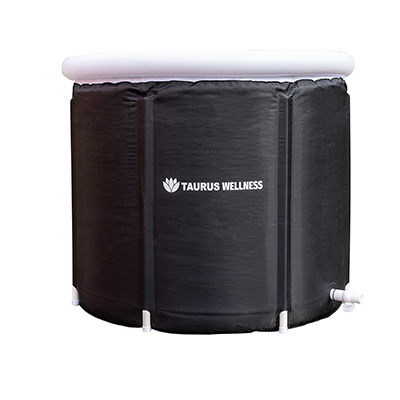
Taurus Wellness Ice Bath
This 420-litre tub gives enough depth for full-body immersion and uses five insulating layers to help keep the water cold. It comes with a drain plug, a rolltop drybag for transport or storage, and an all-weather cover to help keep things clean. The 90 cm diameter provides space to sit comfortably.
Shop →
Shop →
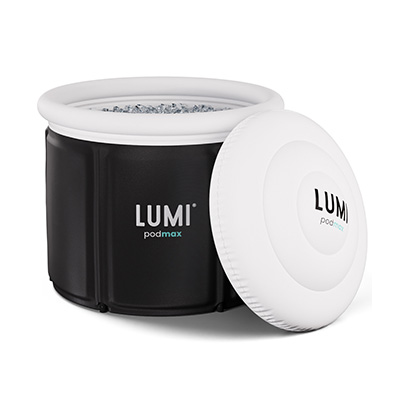
LUMI Recovery Pod MAX Ice Bath
The MAX holds 420 litres and fits users up to 2m tall. With a 90cm diameter, there's enough space to sit in comfortably and submerge fully. It has five insulating layers and comes with six support legs, a drain tap and hose, air pump, repair patches, a UFO-style thermo lid and an all-weather cover.
Shop →
Shop →
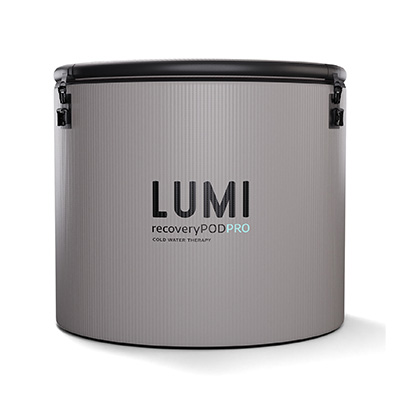
LUMI Recovery Pod PRO
The PRO holds 450 litres and fits users up to 2m tall. It has a 90cm diameter and is designed with thick rubber walls, an insulated base and air gap construction to help maintain the cold. It also comes with an inflatable thermo lid for extra temperature control.
Shop →
Shop →
Why Buy Your Ice Baths From Fitshop?
Fitshop is the longest-established fitness equipment retailer in the UK and Europe’s #1 for home fitness. When you choose to buy from us, you’ll enjoy a range of great benefits, including:
- Expert sales staff offering impartial advice in-store, online, over the phone, via email, live chat, and social media.
- Try before you buy: Most of our Ice Baths and equipment can be tested in-store, and we offer demos of compatible workout apps. Find your nearest store here.
- Interest-free finance: Available both online and in-store to help you invest in your purchase. Find out more here.
- Delivery: We offer various delivery options across the UK through our trusted courier partners. Learn more here.
- Aftercare: Our dedicated team provides world-class support and is available 7 days a week to help with any questions or queries.
SALES TEAM
If you’d like to learn more about our range of Ice Baths or have any other questions, don’t hesitate to contact our in-house commercial sales team at sales@fitshop.co.uk or call us on 0141 737 2250.


